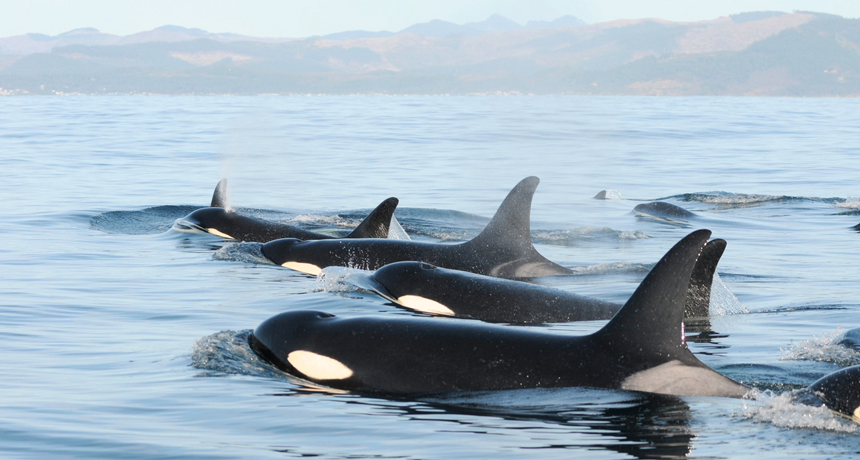These killer whales exhale sickening germs
In samples from whales’ blowholes, scientists found disease-causing bacteria and fungi

These killer whales belong to a population off the west coast of North America, which is endangered with extinction. Researchers sampled the breaths of 12 whales in this group and found disease-causing microbes.
People usually try to give killer whales their space. Getting close to one’s blowhole is especially risky. But Canadian and America scientists got that close — and for a good reason. “We wanted to know what kind of fungi and bacteria they had in their breath,” explains Stephen Raverty, who led the study. His team turned up germs, or microbes, that might cause disease. What they learned may help researchers protect these animals, which are endangered (at risk of extinction).
Raverty is a veterinary pathologist. That’s a scientist who studies animal diseases. He works for Canada’s Ministry of Agriculture in Vancouver, British Columbia. He and his team studied a population of endangered killer whales, or orcas. These are the biggest dolphins on Earth. The group they studied lives off of the West Coast of North America. Scientists call this population the southern resident killer whales. They migrate between California and British Columbia, depending on the season.
As of December 2016, there were only 78 whales left in this group. That’s down from 98, two decades earlier. Scientists hope to keep the population from shrinking even more. Checking the whales’ breath can give researchers a peak into the animals’ health.
The whales hold their breath while diving. When they surface, they exhale in a big burst from their blowholes. Afterward, they inhale fresh air.
The researchers used small motorboats to get within about 6 meters (20 feet) of the whales. By coming at them from the side or back, they didn’t get in the animals’ way or frighten them. When they were close enough, the researchers waved a 5.5-meter pole over a whale’s blowhole as it surfaced.
The pole had five petri dishes attached to it. When researchers twisted the pole’s handle one way, the lids on the petri dishes opened. This allowed them to catch liquid droplets and exhaled breath. When the scientists twisted the pole’s handle the other way, the lids closed again.

The team filled the petri dishes with the exhaled breath from 12 killer whales. In some cases, breaths from the same whale were sampled more than once between 2006 and 2009.
“The whales were very cooperative,” says Raverty. “There was no evidence we scared them.” Still, it took the researchers four years to fill their petri dishes 26 times.
The exhaled breaths did host disease-causing fungi and bacteria. Those microbes would have been living in the whales’ lungs.
The team shared its findings March 24 in Nature Scientific Reports.
It’s normal for certain microbes to grow in the lungs of whales, people and other animals. In fact, microbes live all over our bodies, inside and out. Most of them don’t cause disease. But some can make us sick, especially when they get too plentiful.
The whales may have picked up the disease-causing germs during their migration up and down the coast. “They swim past many populated areas and farms,” Raverty notes. City sewage containing urine and feces can seep into the ocean. Rains can run off of farm fields. This runoff may pick up chemical fertilizers that had been used to help plants (and microbes) grow. Some fertilizers contain animal manure, which may have contained microbes. Both sewage and farm runoff, therefore, could easily wash microbes into the sea.
Just because the whales have disease-causing germs in their breath doesn’t mean they are sick or will become so. But it does mean researchers should watch these animals closely for signs of illness — especially since there are so few of the whales to begin with.
Stressed swimmers
The southern resident killer whales are under a lot of stress. And that worries researchers. After all, stress can weaken an animal and make it less able to fight off disease.
These killer whales face three main stresses, Raverty notes. One is food. There are fewer fish to eat along the coast these days — especially salmon, the whales’ favorite meal. This means the whales sometimes go hungry. Water contaminants are a second stressor. These include toxic chemicals from oil spills and wastes that pour into the water from the land. Lastly, there are a lot of boats traveling up and down the west coast of North America. Some are large fishing boats. Others carry cargo or tourists. All of that traffic and noise can stress out animals that live in the ocean.
Over the years, some killer whales from the group that the Vancouver team studied have died after stranding themselves on beaches. When Raverty and others analyzed the whales’ lungs, they found the same disease-causing bacteria and fungi that have now turned up in the breaths of live whales.
These include bacteria called Staphylococcus aureus (STAF-uh-lo-KOK-us OAR-ee-us). This germ is a common cause of lung and skin infections. Raverty suspects the whales that died were victims of lung infections. These animals were probably already weak from stress and couldn’t fight off the infectious germs.
Raverty’s team now worries that if other whales in the population are very stressed, they too might sicken and die.
For now, researchers have a baseline of data on the type and number of potentially disease-causing germs these whales host. The next time they take a sample, the researchers can compare it to these. This will make it easier to judge the whales’ health, says Joe Gaydos. He is a wildlife veterinarian who specializes in killer whales. He works at the University of California, Davis.
“Killer whales are amazing animals, but it is very difficult to assess the health of free-ranging killer whales,” he says. “One day we may be able to capture a breath sample and not only tell what type of bacteria the whale has in its lungs, but also its state of nutrition and general health.”







